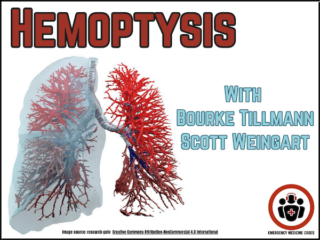Respirology
Ep 204 High Risk Pulmonary Embolism Management
There are many nuances in the management of patients with pulmonary embolism in cardiac arrest, peri-arrest or simply in shock: We need to optimize oxygenation and airway management, hemodynamic support, acid/base management, thrombolysis and/or catheter-directed therapies that Anton dives into with guest experts Dr. Lauren Westafer, Dr. Bourke Tillmann and Dr. Justin Morgenstern... EM Cases is proudly FOAMEd - Please consider a donation: https://emergencymedicinecases.com/donation/
Ep 203 Intermediate Risk Pulmonary Embolism Risk Stratification, Management and Algorithm
How do you predict which intermediate-risk patients will suddenly deteriorate? What role do risk scores, biomarkers, imaging, and hemodynamics play in decision-making? Should these patients receive anticoagulation alone, or is thrombolysis warranted? When should you consider catheter-directed or surgical interventions? This podcast focuses us to think critically about risk stratification, early interventions and escalation in care in PE. We include an algorithm in the show notes. Not all patients fit neatly into classification boxes, making clinical judgment crucial. Join Dr. Lauren Westafer, Dr. Justin Morgenstern, Dr. Bourke Tillman and Anton as they explore the key decision points, pitfalls, and lifesaving strategies for managing intermediate-risk PE in the ED...
EM Quick Hits 62 Optimizing RSI Medication Timing, ED Boarding of Older Patients, Prolonged Tourniquet Use, Rural Peer Support Programs, ECG Reciprocal Changes, Nutrition Tips for Shift Workers
On this month's EM Quick Hits podcast: Anand Swaminathan on optimizing RSI medication timing, Brittany Ellis on ED boarding challenges in older patients and solutions to ED crowding and flow, Dave Jerome on managing prolonged tourniquet application, Nour Khatib and Phil Gillick on a rural peer support case, Jesse McLaren on ECG reciprocal changes in acute coronary occlusion, and Melody Ng on practical nutrition tips for shift workers...
Ep 193 The Crashing Asthmatic – Recognition and Management of Life Threatening Asthma
In this part 2 of our 2-part podcast on asthma with Dr. Sameer Mal and Dr. Leeor Sommer, we dig into the recognition and management of life-threatening asthma. We answer such questions as: what are the key elements in recognition of threatening asthma? What are the most time-sensitive interventions required to break the vicious cycle of asthma? What are the best options for dosing and administering magnesium sulphate, epinephrine, fentanyl and ketamine in the management of the crashing asthmatic? What is the role of NIPPV in the management of life-threatening asthma? What are the factors we should consider when it comes to indications for endotracheal intubation of the crashing asthmatic? What role do blood gases play in the decision to intubate? What are the most appropriate ventilation strategies in the intubated asthma patient? and many more... Please support EM Cases with a donation: https://emergencymedicinecases.com/donation/
Ep 192 ED Adult Asthma Management Strategies For Improved Prognosis – A Stepwise Approach
In this part 1 of our 2-part podcast series on Asthma Management we explore a systematic approach to managing patients presenting to the ED with asthma exacerbations. Our discussion will emphasize the critical role of a thorough history and physical examination in effectively stratifying patient risk and guiding treatment/disposition decisions. Additionally, we'll examine the importance of providing comprehensive discharge medications and instructions to mitigate both mortality and morbidity associated with asthma exacerbations. We answer questions such as: which patients, if any, require peak expiratory flow measurements in the ED? Why is it so important to add steroid MDI therapy to oral steroid therapy in patients being discharged from the ED after an asthma exacerbation? What are the most predictive variables to risk stratify patients with asthma exacerbations to help guide treatment and disposition? and many more. Stay tuned for Part 2, where we'll delve deep into the management of the crashing asthmatic. Please support EM Cases FOAMed with a donation: https://emergencymedicinecases.com/donation/
Ep 188 Hemoptysis – ED Approach and Management
Key principles and approach to management of both non-massive and massive hemoptysis with Dr. Scott Weingart and Dr. Bourke Tillmann, who answer questions such as: What are the factors to consider in the decision to intubate patients with massive hemoptysis? How can one reliably distinguish hemoptysis from pseudohemoptysis? What is the evidence for tranexamic acid in patients with hemoptysis? What are the best strategies for suctioning blood from the airway to improve visualization during endotracheal intubation in crashing hemoptysis patients? What is the role of bronchoscopy and how should it be integrated into the hemoptysis management algorithm? How does one's hemorrhage control strategy change when pulmonary embolism is the underlying diagnosis? and many more... Please support EM Cases with a donation: https://emergencymedicinecases.com/donation/







